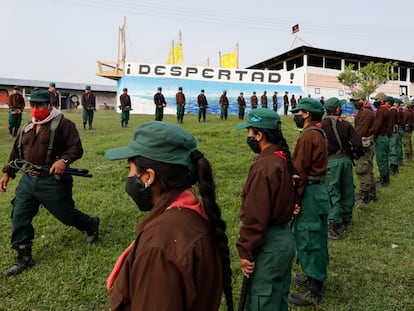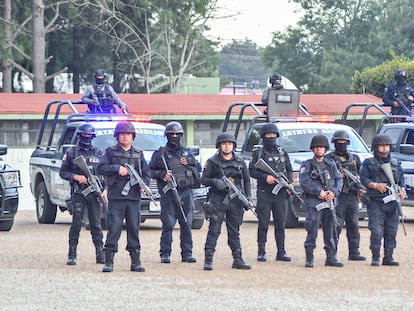Video shows apparent extrajudicial killings by the military in Mexico
Footage shows soldiers disarming the men, sheltering from something, then altering the scene by placing weapons next to the bodies. The victims had just crashed their truck into a wall following a street chase that had residents hiding in their homes in the violence-ridden northern city of Nuevo Laredo
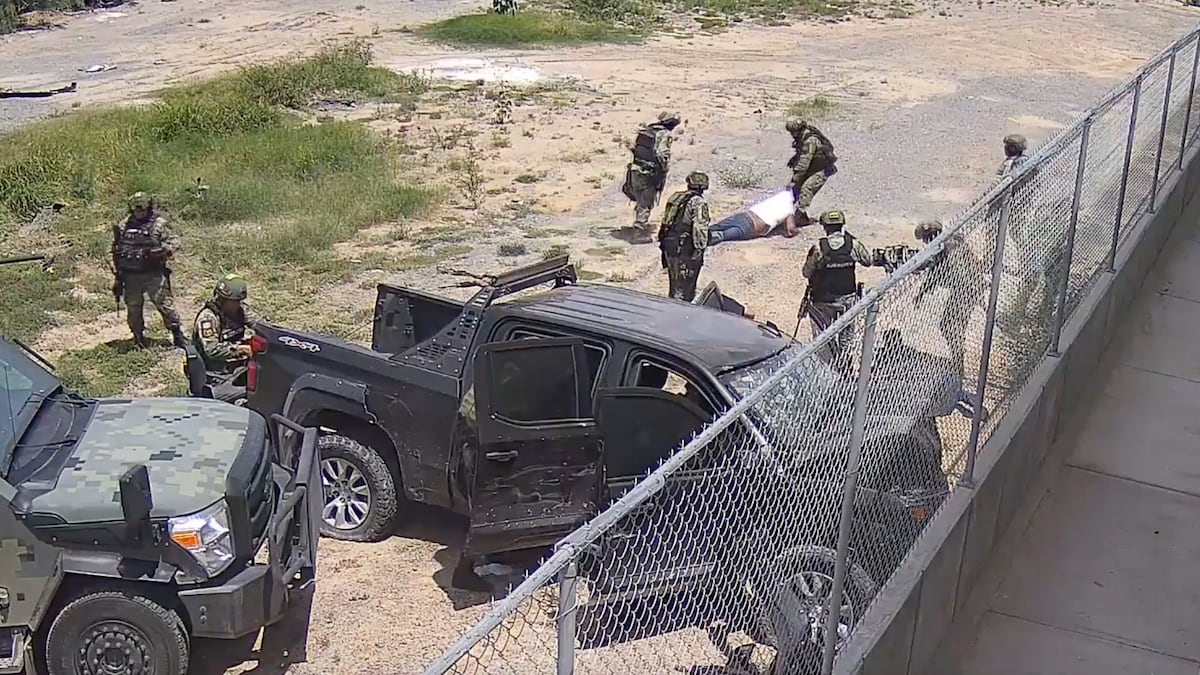

Video footage from a security camera shows a new case of alleged abuse against five civilians in Nuevo Laredo, in Mexico’s northern state of Tamaulipas. The images show that the victims were apparently killed by members of the military. The footage, dated May 18, shows soldiers pulling civilians out of a pickup truck that has just crashed into a wall following a street chase. Some of the civilians are carrying weapons. The soldiers disarm the men, kick them and place them next to the wall. Minutes later, in a confusing scene, the military appear to be sheltering from something, while shooting at the civilians. The only survivor later died in the hospital.
The images, to which EL PAÍS has had access, show how the soldiers also altered the scene of the crime afterwards. In the footage, one of them grabs long weapons with a red bag or cloth to avoid touching them with his hands and leaving fingerprints, then places them next to the corpses. Later, another soldier notices that one of the bodies is still wearing handcuffs. He asks another soldier for the key and they remove the cuffs. In between, paramedics arrive to take away the one survivor, who died later in the hospital. It was hours before representatives from the Prosecutor’s Office showed up.
The officer in charge of the military convoy, Infantry Lieutenant José Luis N, signed the report that was filed with the Mexican Attorney General’s Office (FGR), in charge of the investigation. In the report, of which this newspaper has a copy, the lieutenant states that he and his men were disarming the civilians when some of the latter’s colleagues showed up and began shooting at them “in an attempt to rescue their own personnel.” According to this official, the military responded with gunfire of their own. Meanwhile, the detained civilians were trying to recover their weapons, according to this version of events. When the shooting was over, the soldiers realized that four of the five detainees were dead and one more was in “critical condition” as a result of the crossfire.
The lieutenant’s version contrasts with the video, where no other civilian truck can be seen near the spot, nor anyone shooting other than the soldiers. At one point it seems that the military are trying to take refuge from something, but it is not possible to see whether they are being shot at. In the report for the Prosecutor’s Office, the lieutenant says that “upon further inspection of the spot, two vehicles left behind by organized crime were found on the same avenue, in a north direction.” Inside the two armored vehicles the soldiers found long weapons and a .50 caliber rifle capable of piercing through armor.
The footage shows at least three soldiers shooting at the five unarmed civilians, next to the wall. One out of the five wriggles on the ground, as if he were trying to flee. He seems injured, and he is blindfolded. Seconds later, he stops moving. EL PAÍS contacted a spokesperson for the Ministry of Defense (Sedena) to find out if the agency has taken any action over what happened. Initially, there was no response. In the evening, Sedena released a statement saying: “This agency is cooperating with the FGR in order to establish the corresponding responsibilities.” The statement goes on to say that “Mexican society can be assured that there is no impunity in the conduct of military personnel, nor will any conduct contrary to the rule of law be tolerated.”
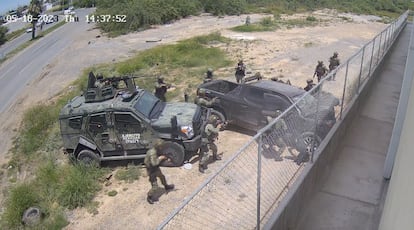
This incident is reminiscent of another one that took place in February in the same city, in a neighborhood known as Cavazos Lerma. The military assassinated five unarmed young men and badly wounded another. The group was heading home after spending time at a nightclub. A seventh young man who was unharmed later said that the soldiers had shot at them for no reason as they were returning home. This witness also said that the military shot one of his friends, who was badly wounded, as he was getting out of their vehicle and when the uniformed men clearly had the situation under control.
The February case received extensive media coverage, because of several videos in which relatives of the victims were seen confronting the military as the latter guarded the scene. Some soldiers fired into the air or at the ground. Civilians managed to knock down several soldiers and kicked them. The scenes illustrated the consequences of the covert war being waged for years in Mexico’s northeast border. The military’s propensity for being trigger-happy — if it was not something worse — had fatal consequences.
When the case came to the attention of Mexican President Andrés Manuel López Obrador, he avoided talk of an undeclared war in the territory and instead supported the theory of an isolated event. Trying to distance himself from the two previous governments, under whose terms there were dozens of cases of extrajudicial killings, torture and forced disappearances perpetrated by members of the Navy and the Army, López Obrador usually frames such cases as one-off mistakes.
The video, step by step
The video footage from May 18 shows the final part of a persecution that began after 2:30 p.m. between Lago Chapala street and Monterrey avenue, in the south of this border city. The video begins when a dark pick-up truck is seen speeding down Monterrey Avenue and crashing into a wall, just below a shopping center’s security camera. It’s 2:36 p.m. After the crash, soldiers appear on foot, pointing at the truck. A military vehicle known as the Sand Cat, a kind of small urban tank, is providing backup.
The Sand Cat hits the passenger door and the rear door, preventing anyone from getting out there. Meanwhile, soldiers take out the driver and his companions from the driver’s side. Some are wearing bulletproof vests and carrying long weapons. The military take the guns away. Some soldiers shoot, apparently at the ground. Stunned from the car crash, the men seem somewhat disoriented. The soldiers restrain them and several also kick them. In his report, Lieutenant José Luis N indicated that “one of them had an exposed head wound, due to the car crash.”
Then the confusing episode begins. The Sand Cat leaves the premises and heads north. At least eight soldiers remain with the detainees. They are close to them, and kick them from time to time. It’s 2:45 p.m. Suddenly, everyone gathers around the civilians’ truck, some on the driver’s side and others on the passenger side. It is possible to see shots hitting the ground, some 15 meters from them, but it is not clear if they are coming from their own weapons or from someone else’s. Most go over to the passenger side except one, who remains on the driver’s side, a few meters from where the civilians are. In the images he is seen shooting at the detainees several times. From the other side of the truck, two other soldiers fire their long weapons at them.
It is then that one of the five civilians tries to flee, crawling on the ground. His face is covered with a bandage. Several of the military shoot at him and he stops moving. The rest do not move, but lie motionless next to the wall. Minutes later, the Army’s Sand Cat shows up again, a few hundred meters further away, on Monterrey Avenue. No other vehicles are visible nearby. It’s 2:48 p.m., everything has happened in just 12 minutes.
Five minutes later, one of the soldiers walk to the back of the truck, facing the avenue. He picks up a red cloth or bag lying nearby on the ground. He pauses for a few seconds because four or five cars are going by on the avenue. The soldiers gesture for them to leave. When no one is passing by, the soldier grabs a rifle, holding it with the bag. He walks over and places it next to the body of one of the dead civilians. Immediately afterwards, he repeats the operation: he returns to the truck, takes another rifle and leaves it next to the body of another of the dead.
In the next few minutes everyone seems already calm. They are sitting or leaning between the truck and the wall. One of the soldiers seems injured, leaning against the right front tire of the truck. His companions seem to be consoling him. In his report, Lieutenant José Luis N stated that this man is a sergeant who was in charge of the vehicle’s machine gun, presumably the Sand Cat. According to this account, the sergeant “was injured by splinters in the face, as a result of impacts that hit the cartridge box of the machine gun.”
Paramedics on the scene
At 3:01 p.m. the Sand Cat approaches the crash site, accompanied by at least three military vehicles. It parks next to the bushes and stays there. Five minutes later, one of the soldiers standing next to the civilian van takes a package from the back seat and gives it to a colleague, who has a cigarette in his mouth. The latter grabs it and leaves the scene. Immediately afterwards, a group of five soldiers, presumably feeling safe due to the presence of the military trucks, approach the bodies on the ground. They touch two with their feet. One of them seems to be still alive. Seconds later the soldiers walk away. At 3:14 p.m., one of those two men on the ground, dressed in white, is seen moving his arms.
No one approaches the dying man. He moves his arms, his feet, while the soldiers look at him from a distance. They seem to realize that they have made a mistake. The soldier who previously placed weapons near the bodies also left one near the wounded man. But the civilian seems to have no strength left for anything. At 3:17 p.m., six soldiers approach him, one carrying a black backpack, another taking aim at him just in case he grabs the rifle. But he doesn’t. It’s not clear what comes next. In his report, Lieutenant José Luis N says that a military doctor administered first aid to the wounded man and that, meanwhile, they called an ambulance. The statement says that the medical vehicle arrived at 3:45 p.m.. By then, the soldiers have already cordoned off the scene with yellow tape. The ambulance arrives and four paramedics take the wounded civilian away on a stretcher.
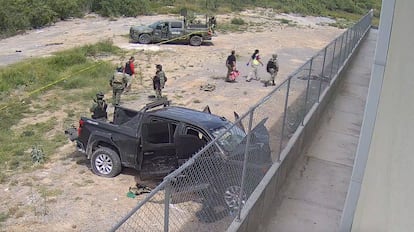
Later they found another truck, on Arandillo street. The military found nothing inside that one, but it had bullet holes. The lieutenant’s report says that those trucks were the ones that were trying to rescue the five detained civilians. The report states that at that moment, after 4:00 p.m., they call the FGR’s office in Nuevo Laredo to report the matter. While they waited, the military tried to clean up any trace of wrongdoing. At 4:28 p.m., one of the soldiers notices that one of the four dead civilians left by the wall is wearing handcuffs. He asks for the keys and takes off the cuffs. Another soldier watches. After a while, experts and prosecutors from the FGR arrive on the scene.
The case made waves in Nuevo Laredo, not because of the possible executions, but because of the number of alerts it generated on social media that day. The street action that ended with the car crash and the alleged killings rocked the south of the city. In videos shared on social media, local residents are seen lying on the ground, sheltering from the bullets. Mayor Carmen Canturosas asked the population not to leave their homes or workplaces. As usually happens in cases like this, the noise subsided into a subsequent silence from authorities.
Sign up for our weekly newsletter to get more English-language news coverage from EL PAÍS USA Edition
Tu suscripción se está usando en otro dispositivo
¿Quieres añadir otro usuario a tu suscripción?
Si continúas leyendo en este dispositivo, no se podrá leer en el otro.
FlechaTu suscripción se está usando en otro dispositivo y solo puedes acceder a EL PAÍS desde un dispositivo a la vez.
Si quieres compartir tu cuenta, cambia tu suscripción a la modalidad Premium, así podrás añadir otro usuario. Cada uno accederá con su propia cuenta de email, lo que os permitirá personalizar vuestra experiencia en EL PAÍS.
¿Tienes una suscripción de empresa? Accede aquí para contratar más cuentas.
En el caso de no saber quién está usando tu cuenta, te recomendamos cambiar tu contraseña aquí.
Si decides continuar compartiendo tu cuenta, este mensaje se mostrará en tu dispositivo y en el de la otra persona que está usando tu cuenta de forma indefinida, afectando a tu experiencia de lectura. Puedes consultar aquí los términos y condiciones de la suscripción digital.
